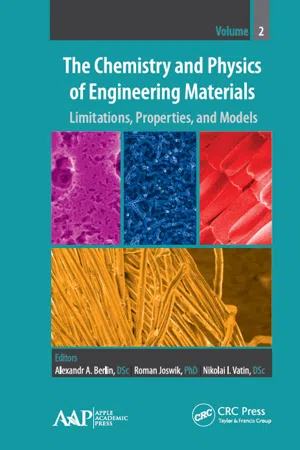
The Chemistry and Physics of Engineering Materials
Limitations, Properties, and Models
- 392 pages
- English
- ePUB (mobile friendly)
- Available on iOS & Android
The Chemistry and Physics of Engineering Materials
Limitations, Properties, and Models
About This Book
This new volume focuses on the limitations, properties, and models in the chemistry and physics of engineering materials that have potential for applications in several disciplines of engineering and science. Contributions range from new methods to novel applications of existing methods.
The collection of topics in this volume reflects the diversity of recent advances in chemistry and physics of engineering materials with a broad perspective that will be useful for scientists as well as for graduate students and engineers. This new book presents leading-edge research from around the world. Topics in the book include:
• aerogels materials and technology
• diffusion dynamics in nanomaterials
• entropic nomograms
• structural analyses of particulate-filled polymer nanocomposites mechanical properties
• protection of rubbers against aging
• structure-property correlation and forecast of corrosion
This volume is also sold as part of a two-volume set. Volume 1 focuses on modern analytic methodologies in the chemistry and physics of engineering materials.
Frequently asked questions
Information
Table of contents
- Cover
- Half Title
- Title Page
- Copyright Page
- Table of Contents
- List of Contributors
- List of Abbreviations
- List of Symbols
- Preface
- About the Editors
- 1. Update on Aerogels Material and Technology
- 2. Quantum-Chemical Calculation of Pentacontacene and Hectacontacene by MNDO in Approximation of the Linear Molecular Model of Graphene
- 3. A New Concept of Photosynthesis
- 4. Entropic Nomogram
- 5. The Structural Analysis of Particulate-Filled Polymer Nanocomposites Mechanical Properties
- 6. The Reinforcement of Particulate-Filled Polymer Nanocomposites by Nanoparticles Aggregates
- 7. The Fractal Model of Polymer Pairs Adhesion
- 8. A Review on Hyaluronan Biopolymer: Properties and Pharmaceutical Applications
- 9. Oil Neutralization in the Turbulent Apparatus Confuser-Diffuser Design of Crude Oil Manufacture
- 10. Structure-Property Correlation and Forecast of Corrosion of the Alkenylarilamines Activity with the Help of Density Functional Theory
- 11. Protection of Rubbers Against Aging with the Use of Structural, Diffusion and Kinetic Effects
- Index